I thrill at checking out every new bit of Dungeons & Dragons 5th Edition material, whether that’s official releases, 3rd party D&D resources, or 5e-Compatible material. And, in 2022, there is a lot of 5e material!
Wizards of the Coast has been ramping up their official release schedule, it feels like there is an infinite selection on DMsGuild, plus massive new projects appear every week on Kickstarter. Given the pandemic-era surge in D&D’s popularity, plus its mainstreaming via Stranger Things and live play shows like Critical Role, I don’t think the tempo of releases will be letting up any time soon.
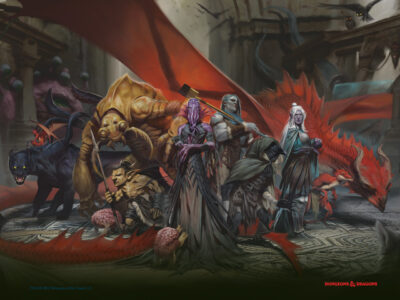
With so much 5e material to choose from… how exactly do you choose? Almost every player will start with either a Player’s Handbook or a Dungeon Master’s Guide, what should be your next purchase?
I think it’s important to understand what you’re looking for out of a supplement. Otherwise, it all looks equally attractive and you wind up buying more books than you could ever reasonably play through.
Even I, notable obsessive collector of stuff, know not to pick up certain materials with additions that will never make it to my virtual tabletop.
When it comes to choosing the right materials for you, I’d say that vast majority of official D&D, 3rd party D&D, and 5e-Compatible materials offer content that falls into one or more of nine possible categories. I’ve ordered them from the most-expansive to the most-granular, in terms of what they add to the game. =
- Rule Sets
- Game Worlds & Settings
- Adventures & Campaigns
- Creatures
- Playable Races
- Classes & Sub-Classes
- Equipment & Items
- Spells
- World-Building, Tools, Maps, & Game-Aids
Keep reading to understand what I mean by everything on the list! And, for each category, I cover the best official books and some of my favorite 3rd Party releases!
![]()
D&D 5th Edition & 5e-Compatible Content Categories
1. Rule Sets
Who is this for? DMs who love to experiment.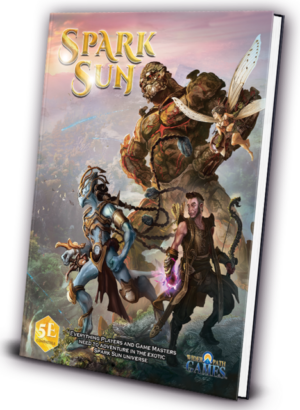
This includes new, overarching game mechanics that could affect any player or campaign, regardless of their races or classes (although it might add some races and classes).
Think about rules like rules for underwater combat, a magic system not based on spell slots, or some other fundamental change or addition to the core rules laid out in the Dungeon Master’s Guide and Player’s Handbook.
Often, 5e-Compatible Rule Sets are paired with Campaign Settings, since unique rules are often tied closely to world-building. However, that doesn’t have to be the case.
Positives: Bring unique flavor to your players. Fill a specific niche unaddressed by core D&D 5e.
Negatives: Additions from 3rd party or 5e materials may not be compatible with online tabletop systems, or even with your existing character sheets. Non-official rules may not be thoroughly playtested. You’ll be the only one at the table who understands them thoroughly.
Sample Official Release: Acquisitions Incorporated, a D&D + Penny Arcade team-up, offers rules for creating, running, and staffing a franchise of an adventuring business. Ghosts of Saltmarsh is primarily an adventures-focused book, but the appendix contains rules for ship-to-ship combat.
Sample 3rd Party Release: The Greasemonkey’s Handbook: Rules for piloting Magitech, Steampunk and Sci Fi mechs in D&D 5th Edition brings stat blocks and mechanics for player-piloted mechsuits to 5e. I recently backed a Kickstarter for Spark Sun, a 5e-Compatible world which brings a non-spell powers system to 5e that you access by manipulating your “spark” of life.
![]()
Game Worlds & Settings
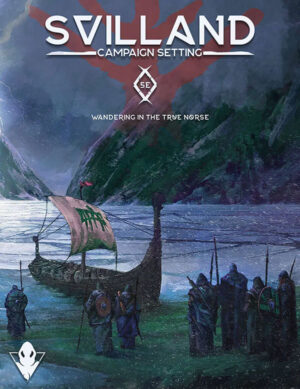 Who is this for? DMs who don’t want to build their own world from scratch, even if they like to make up their own adventures.
Who is this for? DMs who don’t want to build their own world from scratch, even if they like to make up their own adventures.
This includes any book that introduces entire cities, regions, worlds, or planes. These settings can be full of history, culture topography, story hooks, and factions. A Campaign Setting often involves a Rule Set, and it might necessarily include some of the other categories below, like Adventures, Races, or Creatures. However, books focused only on those elements won’t include the amount of world-building that a Campaign Setting does.
This is where 5e-compatible releases really shine, since they have no restrictions on how, when, or where they set their worlds. While D&D 3rd party releases preclude the creation of entire worlds, you can still find campaign settings that invent or more-fully-detail regions or cities within the known realms of D&D.
Positives: Can either provide you a world to run your campaign or adds flavor and history to your own unique world.
Negatives: Hard to judge quality without reading an entire book. Sometimes linger on details that will never camp through for players. Might not be compatible with your planned adventures.
Sample Official Release: There are several notable D&D Campaign Settings, but I love Eberron: Rising From The Last War. It focuses on what makes Eberron different from other fantasy worlds, starting from its creation through its most recent post-war era. That has impacts across multiple standard races to give them a unique flavor. In terms of adding lore, the inexplicably discontinued Mordenkainen’s Tome of Foes contained perfectly-organized information on Devils and Demons.
Sample 3rd Party Release: I recently received my Kickstarter books from Svilland, which is a Norse Mythology-themed 5e setting. Not only are the books gorgeous, but I appreciate their stripped-down take on swords-and-spells.
![]()
3. Adventures & Campaigns
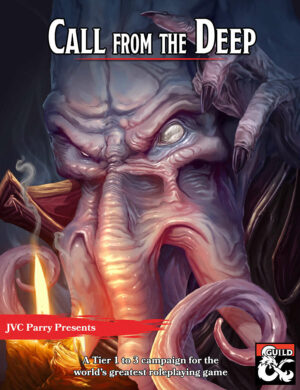 Who is this for? DMs who want some or all of the specific path of their campaign mapped out for them.
Who is this for? DMs who want some or all of the specific path of their campaign mapped out for them.
Adventures are the lifeblood of playing a table top RPG – they are the narrative that the party experiences during their play. The best adventures are living, breathing, choose-your-own-path stories that account for multiple different player choices at every step. They plan for parties who love to negotiate as well as ones who slay first and ask questions later.
However, an adventure is more than just a storyline. Adventures also offer maps, encounters, puzzles, and even scripts to aid a DM’s storytelling and make things more immersive for players. Plus, and adventure will link to or add new creatures and treasure to populate your campaign.
A release might be just one adventure, a collection of unlinked adventures, or multiple sequential adventures that form an ongoing campaign. Most adventures will list a level range, which can either mean that they are appropriate for characters of those levels or (in the case of campaigns) that they are meant to advance characters to the highest level in the range.
The challenge of choosing an adventure is that the authors don’t know the vibe of your party. Only you do. I’ve found many adventures with detailed rules for specific puzzles or encounters that my party just skips, or that don’t have the depth I know my gang will seek from conversations with NPCs.
Pros: Takes the hardest work out of running D&D sessions!
Cons: Hard to judge quality without reading an entire book. May be missing key connective tissue (even in an official campaign book!)
Sample Official Release: Of the official D&D releases, I think Storm King’s Thunder is the gold standard for a campaign book. It includes a story rich with detail and hooks so that your players have multiple ways to react and change the story as they progress.
Sample 3rd Party Release: D&D Adventurer’s League are actually official, digital-first releases that extend a particular D&D campaign book like Storm King’s Thunder and are standardized for official pick-up games at conventions and stores. They’re all cheap, highly-detailed, and are able to be run in 2-4hrs.
Call of the Deep is a beloved, highly-detailed 3rd party campaign, and its creator is very active in answering DM questions to help them troubleshoot their campaigns. Eyes Unclouded includes 11 one-shot adventures with a Studio Ghibli vibe.
![]()
4. Creatures
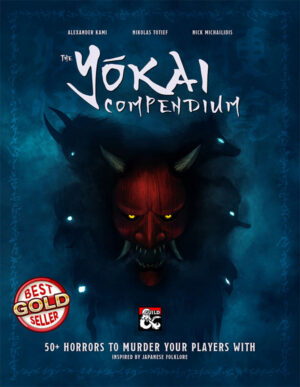 Who is this for? DMs who want to bring more variety to their encounters.
Who is this for? DMs who want to bring more variety to their encounters.
Whether they’re devious humanoids or terrifying monsters, creatures give your adventurers something to fight! Creatures are often expressed as “unique stat blocks” – meaning, how many specific creatures with their own stats are in a book.
Regular D&D players grow extremely familiar with the standard goblins, kobolds, and bug bears that populate the Monstrous Manual. Sometimes that can work in your favor, as your party will be excited to encounter their first Gelatinous Cube or Mind Flayer! However, it can also detract from your game when experienced players already have common stat blocks (with all of their armor class, weakness, and damage rolls) committed to memory.
Official D&D sourcebooks and adventures often add a fistful of unique creatures, but this is where 3rd party materials really shine. There are books upon books of creatures to add to your campaigns – whether that’s brand new fantastical foes, creatures imported and upgraded from past editions, or event adaptions of bestiaries of other fictional worlds.
Books of creatures can offer more than just stat blocks. Often they will detail the history or ecology of a particular creature, detail their lairs, or offer story hook suggestions.
Pros: You can never have too many creatures! It’s fun to keep things fresh and unexpected for your players.
Cons: Challenge Level accuracy, difficulty, and balance varies widely, even within official releases. Keeping track of the creatures you want to use across different books can be annoying.
Sample Official Release: The new Monsters of the Multiverse book out in the past month compiles creatures from several past releases and makes minor tweaks to level-set them with the current meta of the Dungeons & Dragons universe. However, my personal favorite is the now-discontinued Volo’s Guide to Monsters, which offered in-depth chapters on the lore behind Beholders, Giants, Gnolls, Goblinoids, Hags, Kobolds, Mind Flayers, Orcs, and Yuan-ti. Hopefully these awesome chapters turn up elsewhere sometime soon.
Sample 3rd Party Release: I’m a major fan of the Monster Manual Expanded series of three massive tomes, available as PDFs and via print-on-demand. While this trio of books sometimes lead too hard on offering many “variations on a theme” of a single creature, I actually like the idea of taking one creature concept and making it work at several different challenge ratings.
For something different, I’ve recently used The Yokai Compendium to introduce creatures from Japanese folklore to my campaign. In the category of both stat blocks and lore, The Draconomicon is in many ways superior to the official Fizban’s Treasury of Dragons.
![]()
5. Playable Races
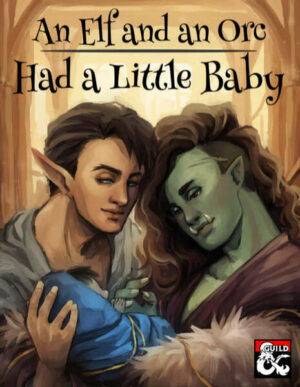 Who is this for? DMs who want to offer players the opportunity to be more than just a human, elf, dwarf, or other “regular” fantasy class. Players who want to unleash their imaginations before getting to character creation.
Who is this for? DMs who want to offer players the opportunity to be more than just a human, elf, dwarf, or other “regular” fantasy class. Players who want to unleash their imaginations before getting to character creation.
Do your characters want to play as a dragon, a talking four-legged animal, or a Na’vi from Avatar that just barely skirts copyright rules? And, when will D&D bring back my beloved Swanmays?!
Official Dungeons & Dragons currently offers more than 60 playable races, with most new Sourcebooks adding at least one. We’ve gotten far past the standard fantasy races and into mythological creatures like Minotaurs, sentient machines like Warforged, and all sorts of animal-folk like rabbit- and owl-people.
That still might not cover the specific sorts of races that fit best in your world or for your players. I find that when I am looking for new race options I am often shopping for something specific rather than a massive list. How many races on that list might I or my players actually develop into characters?
Positives: Makes your campaign world feel fully-realized and lets players feel unique.
Negatives: Can be wildly unbalanced. Racial features and bonuses from 3rd party materials might be impossible to implement on your digital platform.
Sample Official Release: Again, the new Monsters of the Multiverse book is now the go-to for this. It compiles thirty-three playable races from prior books, smoothing them out for the current direction of the D&D rule set. However, it omits setting-specific races like Simic Hybrids and Warforged.
Sample 3rd Party Release: Honestly, before you buy any book, I have to say that DNDBeyond’s Homebrew Section is where it’s at when it comes to unofficial races. People have developed everything, often including thinking up better versions of official D&D races before they’re even released. Plus, you have the added bonus of stats of how often races have been viewed and upvoted to tell you what works.
I’m also in love with the brand-new An Elf and an Orc Had a Little Baby Volume One & Volume Two, which address parenting and lineage in D&D and offer you ways to craft multi-racial characters beyond just half-elves and half-orcs.
![]()
6. Classes & Sub-Classes
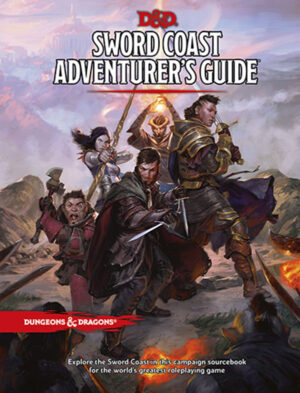 Who is this for? Players who couldn’t quite build the character they wanted using official rules. DMs who want to insert additional flexibility or specificity into their class system.
Who is this for? Players who couldn’t quite build the character they wanted using official rules. DMs who want to insert additional flexibility or specificity into their class system.
Every player character in Dungeons & Dragons has one or more classes, which are archetypal roles that define the abilities they can access as they level up in the game. At Level 1 the difference between a Fighter and a Cleric might just seem like a few hitpoints and a healing spell, but as early as Level 5 classes play radically different from one another.
Within Classes, Sub-Classes offer different variations on the Class abilities that players receive at prescribed levels. Does your Cleric want to channel thunder in every blow or have instant access to divine knowledge? Is your Fighter a standard sword-slinger, a distanced Arcane Archer, or magical Echo Knight? These options offer the kind of flavor differences that make players feel unique and that keep them engaged in your game.
Core D&D currently offers a total of fourteen classes. While they cover a wide range of potential characters – including many varieties of magic-users – they don’t perfectly fit every famous fantasy archetype.
3rd party and 5e-Compatible books offer all-new classes that are different from the core D&D 5e classes (e.g., “Demon Hunter” as a distinct class from Fighter, Ranger, or Paladin), as well as custom sub-classes for those existing classes (e.g., “Demon Hunter” as a speciality for the existing Fighter, Ranger, or Paladin class).
I’d also lump additional class options like Feats & Skills into this category, since they’re often packaged alongside classes.
Positives: Allows players to find the specific niche they desire for their characters.
Negatives: Even within official D&D, some of the more unusual Classes and Sub-Classes offer wild new additions to game balance that may make the job of the DM more difficult. Unofficial classes can be downright game-breaking. The features and bonuses of unofficial classes might be impossible to implement on your digital tabletop platform.
Sample Official Release: D&D has only added two new classes outside of the Player’s Handbook, but where the real value comes tends to be in sub-classes. The Sword Coast Adventurer’s Guide offers a slew of Sub-Class customizations that massively expand what’s possible for characters, as does Xanathar’s Guide to Everything.
Sample 3rd Party Release: Brandon’s Big Book of Bards is misnamed – it’s only 12 pages! However, it offers many different Sub-Class options for Bards that are more-rooted in different performance backgrounds, rather than just using Bards as Swiss Army Knife spell-casters.
![]()
7. Equipment & Items
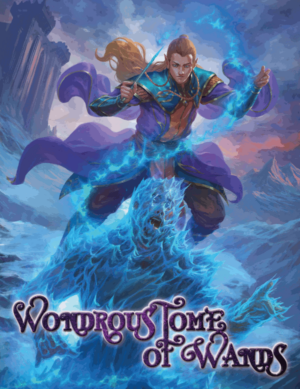 Who is this for? DMs whose players love treasure and visiting new shops, or who need new high-level equipment so their players can tackle tougher encounters. Players who are focused on crafting and want to propose possibilities to their DMs.
Who is this for? DMs whose players love treasure and visiting new shops, or who need new high-level equipment so their players can tackle tougher encounters. Players who are focused on crafting and want to propose possibilities to their DMs.
Equipment is stuff! This can include equipped items like weapons and armor, but also tools and magical doodads. While the standard D&D kit is fine for the first few levels, characters will want new equipment as they increase in level to assist them in more-difficult encounters.
Positives: Gives you more options as a DM. Allows players to set individual goals that you can use to steer your story, whether that’s quests for specific items or just enticing them to earn lots of gold.
Negatives: It’s impossible to keep track of all of the various pieces of equipment scattered through various official releases if you don’t have DNDBeyond. In 3rd Party and 5e-Compatible releases, equipment is often not as unique as marketing copy would have you believe. Sometimes 3rd-party equipment is just existing equipment with different names, or an item with a random existing spell tied to it.
Sample Official Release: No single official release is particularly great for this, but Tasha’s Cauldron of Everything has a solid chapter of magical items that’s much deeper than the few pages of tables in most books.
Sample 3rd Party Release: Honestly, there are so many equipment-filled releases it’s hard to pick! All The Weapons offers variations on many of the common forms of D&D equipment. For a cheap pick with lots of bang for your buck, Ancestral Weapons has over 100 weapon options.
And, I love the incredibly niche The Wondrous Tome of Wands. And, I am a major supporter of Monster Loot, which lists all of the various bits of equipment and biological material your players can harvest from fighting creatures from all of the official releases.
![]()
8. Spells
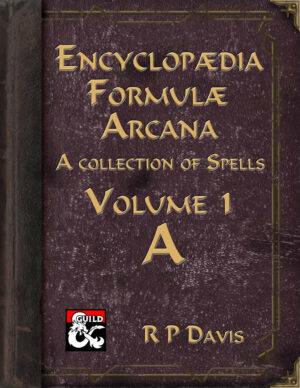 Who is this for? Players who feel like the current spell options don’t allow them to fully express their character.
Who is this for? Players who feel like the current spell options don’t allow them to fully express their character.
For Dungeons & Dragons magic-using classes, Spells really do make the character – or, at least, they make them fun.
I think this is the weakest aspect of the current D&D release system, which really dissuades players from making highly-customized magical characters. Spells are spread out widely across different books and it’s hard to understand which spells will become available to your specific Class and Sub-Class. And, rules for learning spells and expending spell slots remain as fiddly as ever, and a real pain to manage without a digital table-top system.
That makes 3rd-party and 5e-Compatible books a real lifesaver for magical players and their DMs. Having a huge tome of decently balanced spells in your hands saves you from having to buy several different books just for 2-3 spells per book. And, keep in mind, DMs can break the rules of who gets what spells whenever they feel like it – especially if that comes with story reasons!
Positives: Makes your campaign more unique and lets players feel special.
Negatives: Can be wildly unbalanced.
Sample Official Release: Outside of the Player’s Handbook, Xanathar’s Guide to Everything has one of the highest-concentrations of spells in a single book. Most other releases contain only a handful. I wouldn’t be surprised to see a player-oriented compendium like Monsters of the Multiverse collect all of the spells into one place in 2023.
Sample 3rd Party Release: The #1 digital option for you is Encyclopaedia Formulae Arcana, which is methodically up-converting spells from prior D&D editions one letter at a time. Even with just a few letters of the series, you’ll massively expand your selection – K alone includes 46 spells for $5.
If you’re looking for sheer quantity and are less concerned with quality, Blackstaff’s Book of 1,000 Spells has tons to choose from – even if some are marginal. Spells from Elsewhere offers only a 10th of that for a similar price, but they are original spells rather than converted spells from prior editions.
![]()
9. World-Building, Tools, Maps, & Game-Aids
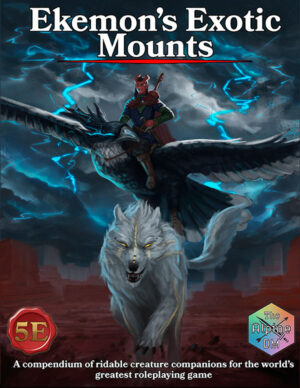 Who is this for? Everyone who wants more options and references at their fingertips.
Who is this for? Everyone who wants more options and references at their fingertips.
This is a catch-all category includes helper tools for both the DM and players.
This category includes pre-built in-world resources like taverns or NPCs, expanded niche rules for things like brewing or summoning mounts, and game aids like random roll tables, injury lists, or reference sheets.
If your campaigns are anything like mine, there’s always that one thing that no one can remember, whether that’s how to break Concentration or how much a pint of ale should cost. Or, maybe as a DM you find you need some extra ideas when it comes to how to describe critical misses. Sometimes a well-organized 4-page PDF or game screen can save you cumulative hours of checking the rules or um-ing and aw-ing through an explanation.
Plus, official books often don’t go deep enough on that one particular thing that your players love the most.
There’s no positives or negatives here. With these sources, its easy to use the things you like and discard what doesn’t work.
Sample Official Release: Of all the official books, I feel like Van Richten’s Guide to Ravenloft gives the most solid, actionable advice when it comes to the minutia of in-game storytelling.
Sample 3rd-Party Release: This is probably the category of thing I get the most obsessed about, because I love good trove of ideas I can adapt into our home-brew campaign.
This week my physical copy of Glorious Taverns by Critit.co.uk arrived and I am in love with it. I will never scramble to make up a tavern on the spot ever again. You can get a sneak-peak now prior to general release.
I also love the 5e-Compatible Ekemon’s Exotic Mounts from The Alpine DM. I covet any kind of game aid that gives me instant depth for encounters, like the Blooded & Bruised series. And, I am a massive fan of Patreons that regular pump out easily adaptable maps for random encounters, with my favorite being Seafoot Games. Their stuff is incredible.
![]()
That’s my overview of how I evaluate every Dungeons & Dragons official material, 3rd party release, and 5e-Compatible book!
Starting next week, when I highlight a new D&D or 5e release from any of those sources, I’ll rank it across these nine criteria to explain why I think it’s worth buying.
[…] Today I’m going to offer a glimpse at the dozen projects that are wrapping up the soonest, viewed through the lens of last week’s essay, “What makes a good Dungeons & Dragons 5th Edition official release or 5e-Compatible supple… […]